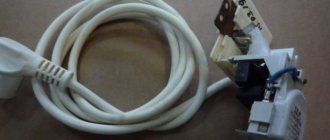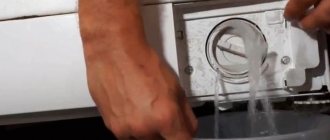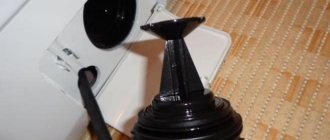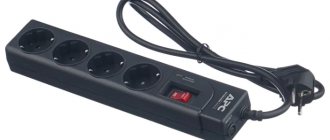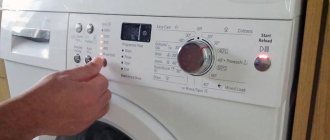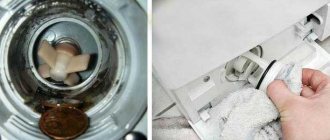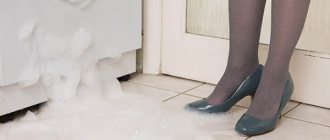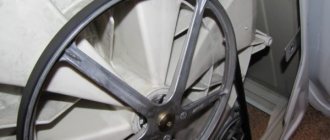Modern equipment is very sensitive to power surges, so surge protectors are used to protect it.
The parts of such devices are located inside a durable housing and are filled with a special mixture that does not allow current to pass through.
They are sealed, as they are used near water, and cannot be repaired, only replacement is possible.
Today you can buy a surge protector for an LG washing machine or any other manufacturer, as well as additional devices connected to the network.
What role does it play?
Frequent relay switching, starting and stopping the asynchronous motor inside the machine itself, in turn, cause constant changes in currents that cannot be passed into the external electrical network so as not to damage other electrical equipment connected to it (TVs, computers, microwave ovens, etc.) This the device detects these differences and “dumps” excess currents to ground. The washing machine surge protector protects from voltage surges not so much the machine itself as the external electrical network from it.
A strong voltage drop in the network can lead to the combustion of an asynchronous motor, because it stops rotating, and current continues to flow into its winding. In this case, this protective device immediately turns off the washing machine. If the voltage drop is short-lived, the filter uses the charge of its capacitors to maintain normal operation of the machine. That is why it is not recommended to operate the washing machine without it.
In the event of a breakdown, the surge protector can only be replaced as a whole assembly, since its parts are filled with a special waterproof compound that does not allow current to pass through.
These are fairly reliable devices and they rarely break, but sometimes it happens. Most often this occurs due to a decrease in the capacitance of the capacitors inside the filter over time. Less often - due to a strong voltage surge, which can cause a breakdown.
Under no circumstances should you turn off a running washing machine by unplugging it from the socket - this can also damage the filter!
You can get and replace the interference filter yourself or with the help of a specialist, but how can you tell if it’s broken?
Surge filter for an automatic machine: what is it and why is it needed?
In order to avoid paying for expensive repairs, you can take care of proper protection of your automatic washing machine in advance. A surge protector for a washing machine comes to the rescue. Network filter:
- perfectly smooths out any voltage fluctuations;
- saves equipment from breakdown due to power surges and sudden drops;
- ensures a normal washing process, without any interference;
- protects household appliances adjacent to the washing machine from high frequency currents that can enter the electrical network during operation of the washing machine.
But you should not mistake an extension cord that has several outlets for such a protective filter. The extension cord can be used for all household appliances in general, and the surge protector takes on the protective functions of the complex system of the automatic washing machine and other household appliances surrounding it.
Surge filters can be built into the machine at the factory, or can be purchased separately by the consumer to connect the washing machine to the power source through it. The built-in network filter is a housing made of impact-resistant material that does not conduct current. All parts are protected by a non-conductive liquid poured into the housing.
Modern washing machines are very complex systems that require reliable protection and an even and stable power supply.
If the component equipment receives high or, conversely, low impulses, it burns out and requires replacement. This is especially true for machines with touch controls; they are very sensitive to even the slightest voltage drops. Therefore, surge protectors are installed on such devices by the manufacturer. As a rule, it is located where the electrical cord exits. See also -
How to replace the water supply hose for a washing machine
Troubleshooting
Most modern washing machines are designed in such a way that if the interference filter fails, they automatically stop working and do not start until the broken part is replaced. Therefore, the very first evidence of a breakdown is the inability to turn on the machine. Of course, this can be caused by other problems, the simplest of which is damage to the power cord or its plug. But if everything is in order with them, then the noise filter is next in line.
Also, if the machine suddenly began to electrocute, there was a smell of burnt insulation, or the machine spontaneously began to change operating modes during washing (regardless of the program you chose), all this also indicates a malfunction of the surge protector.
If you have a multimeter (a device for measuring resistance, voltage and current), then in this situation you should use it so as not to call a technician:
- First of all, you need to call all contacts in pairs. The resistance should be about 680 kOhm.
- Next, measure the input resistance at the plug. The resistance should also be around 680k ohms, although it may vary slightly.
- It is quite difficult to check the condition of the capacitors due to the fact that they are filled with compound. But you can try to measure the capacitance between different inputs. Its value should be about 0.47 µF.
If, when ringing the contacts, you notice that the resistance is infinity or the capacity tends to zero, then the device is damaged and needs to be replaced.
Power cord
Frequent use and mechanical movements may damage the power cord. Check to see if your washing machine needs repair; the plug is simply not fully plugged into the socket. This happens when the plug is not removed from the socket for years. Accordingly, the contacts adjacent to the plug weaken and relax. If this is not the reason, then mechanical damage, melting and burning of the plug is possible.
Checking the power cord means “ringing” all three wires of the power cord with a regular tester. The cause of the breakdown may be that during operation of the wire, it is subjected to mechanical stress and can easily be damaged. To check the wire, you need to “ring” 3 wires of the power cord using a multimeter. If you find a problem, call a repairman. You should not replace the power cord yourself.
Criterias of choice
You can find a new surge protector of the desired brand anywhere: in a household appliance store, in an online store or from an official supplier. If you cannot find a “native” one, it can be replaced with one with similar electrical characteristics.
In this case, first of all, you need to pay attention to the maximum pulse overload current and the maximum current consumption, the value of which should be 2-3 times higher than that of the washing machine (calculated from the power).
You can also temporarily replace a broken filter with an external auxiliary filter, which itself is connected to the mains through an outlet, and all electrical appliances are connected to it.
The principle of operation of the interference filter
In standard situations, the device is capable of transmitting vibrations with a frequency of 50 Hz. All deviations from this indicator in any direction lead to the part blocking the operation of the washing machine. It should be noted that the washing machine’s protective device does not always withstand excessive voltage drops in the electrical network. In such cases, it loses its ability to work and needs to be completely replaced. To create maximum security for household appliances, a stabilizer device is used in combination with a network interference filter.
Conclusion
Now you know a little about what can cause your washing machine to not work. And you won’t panic if this happens. Remember that surge protectors rarely fail without reason. This requires a serious external overload of the electrical network, exceeding the protection capabilities (lightning strike, welding machine on the same line, etc.).
But if the washing machine has served you faithfully for a long time, then over time the surge protector may break on its own - from old age.
How to check the interference filter on a washing machine
Many washing units are designed in such a way that if the power filter fails, they automatically stop their operation and will not start until the failed element is replaced. The conclusion that follows is that the washing machine does not turn on, and the plug and cord are in good condition; it is necessary to check the device for interference. In cases where the washing machine receives an electric current or a burning smell is felt, the unit independently changes operating modes - the network interference filter is checked.
The algorithm of actions is as follows:
- We check all contacts in pairs with a multimeter, the resistance of which should be 680 kOhm;
- The input resistance of the plug is measured. The value should be as in the first case. Some upward deviation is allowed;
- It is difficult to check the serviceability of capacitors, but it is possible to measure the capacitance between different inputs. The indicator is within 0.47 µF.
How the filter works
If a surge protector is built into a washing machine, then it can pass oscillations with a frequency of 50 Hertz , and the remaining impulses will be immediately blocked.
This is a significant point, since if we consider network outages and surges, then significant surges in amplitude can cause damage to the machine’s systems, including complete loss of performance.
When using the protective device, it is forbidden to turn off the washing machine from the outlet during operation , as the filter may break.
Even simple inductors with a small capacitance are good, the only problem is that they will not be able to withstand a strong voltage surge.
Some users are convinced that it is not necessary to install a surge protector. Perhaps older models of washing machines will most likely be able to cope with the amount of current.
But, modern equipment without protection will easily suffer from another instability in the network and by starting the washing process, the user may lose the control panel, motor, heating element, etc.
Instability can also occur in the device itself. When an induction motor is started, a number of peaks are generated or current dips occur, which can result in high-frequency harmonics. But, thanks to the protective filter, this process is smoothed out, because the filter catches such differences and resets them to ground. In this way, it protects devices and appliances connected to an external power supply (microwaves, computers, TVs and others) from damage.
You should take into account the fact that if a malfunction occurs in the network filter, for example, an asynchronous motor burns out, then the operation of the entire washing machine completely stops for safety reasons.
Filter faults
The surge protector rarely fails.
It is not always clear how to check the power filter of a washing machine. Its performance is determined by ringing the terminals at the input and output using a multimeter .
There are times when there is a problem with the input impedance. To solve it, just bite the “crocodiles” on the plug. With detachable terminals this cannot be done; they are simply uncoupled first and then measured in pairs. The resistance should be 680 kOhm.
If the results are positive, you need to pay attention to the capacitors . They are switched on in parallel, and the values need to be summed up. They turn on one by one and the total value of the reciprocal is found.
If in the end the summed result does not coincide with the indicators required during normal operation, then the condensate has burned out.
Is a surge protector needed in a washing machine? The answer is unequivocal - yes. The choice of a protective device must be taken seriously. Every user of a washing machine must protect it from power surges and surges - no doubt.
Network filters (interference filters) are designed to suppress pulse and high-frequency interference that periodically occurs in the electrical network. The surge protector for a washing machine is designed to suppress any frequencies other than 50 Hertz. A large surge or drop in electrical power can interrupt operation or damage the electrical equipment of the machine.
Online diagnostics of a washing machine
If your machine stops washing or rinsing clothes normally, then some kind of malfunction or breakdown has occurred.
You can try to find the problem yourself. Run diagnostics
Select which operation your washing machine does not perform:
1. Doesn’t drain 2. Doesn’t rotate the drum 3. Doesn’t spin clothes 4. Noises, knocks, buzzes when spinning 5. Doesn’t turn on
Checking the operation of the drain pump Is the drain pump of the washing machine working? Yes No I don’t know << Back
Clogged hoses in the washing machine If the sound corresponds to the normal sound that has always been observed when the device is working, the cause is probably a clog.
Was there a blockage in the drain hose? Yes
<< Back
The drain pump does not work! If the sound matches the normal sound of the drain pump, it is recommended that you check the drain filter first.
After cleaning, does the drain pump work and does the washing machine drain water? Not really
<< Back
Operation of the drain pump The sound of the pump is usually immediately audible and noticeable. If there is no sound, the pump is not working. We are looking for how to separately enable the water drainage program. As a rule, this is a separate option. After the program has been turned on, the pump should start working in 1-3 seconds. If everything is done correctly and the pump is operational, a buzzing sound will appear. If you hear no buzzing or other sounds when you turn on the program, the pump is probably faulty.
Is the washing machine drain pump working? Not really
<< Back
Clogged car hoses If you have identified a clog in the hoses, you need to disassemble them, clean them, and then reassemble everything.
Does the washing machine drain well? Not really
<< Back
Hurray, you did a great job, you fixed it.
<< Return to the beginning of diagnostics
The drain pump is faulty, call a professional.
<< Return to the beginning of the diagnosis.
The washing machine does not rotate the drum. During the operation of the washing machine, such a problem may occur. Each model has a different drum operation. It rotates according to a given algorithm, which is set by the program. This principle applies to spinning and washing. If you are not sure whether the drum is not spinning or whether it is working, put the laundry in the washing machine. Start the spin program. If the machine is running, it will first drain the water and then start spinning. In this case, a rotational process will be observed. If rotation is not visible, then check the belt. First, turn off the program, then unplug the wire from the outlet so that power does not flow into the device. Now you need to remove the back cover. You will need to carefully inspect the drum belt. It is quite easy to determine whether it is in the wrong position or damaged.
Is the washing machine belt torn or stretched? Not really
<< Back
Broken drum drive belt If the belt breaks, it will be immediately visible. There are also often cases when the belt simply stretches, which is why the drum, accordingly, does not rotate. Do not allow the machine to operate if the belt breaks. It is important to check whether it has wound around the engine pulley or broken the wiring to the engine. The heating element and temperature sensor may also be damaged if the belt does catch the wires. It is imperative to ensure that the belt model is original. If you choose an unsuitable or low-quality product, this will affect the performance of other devices. How do you know what kind of belt you have? There will be a marking written on the old one, compare it with the one indicated on the belt offered to you. You can also find out belt information by car model.
<< Return to the beginning of the diagnosis.
Washing machine motor malfunction If a malfunction is not found, the block with wires must be disconnected from the electric motor. Carefully remove it. We visually evaluate the engine. It may have melting, cracks, or other effects that clearly indicate damage. We call the windings of the tachogenerator and the engine. It is important to understand that you can fully study how correctly the engine operates and whether there is a malfunction only at the stand. If rotation does not occur, there may be a problem with more than just the motor. Sometimes the cause is a malfunctioning electronic module. If a short circuit occurs in the engine, the module could be damaged, while the engine remains operational. Also, the wires could be damaged.
<< Return to the beginning of the diagnosis.
Repairing a washing machine that does not spin clothes After completing the washing process, the washing machine may not spin properly or may not start spinning. Firstly, look, perhaps another mode is set, which does not involve turning on the spin cycle at all. This happens, for example, with programs related to washing woolen items and delicate fabrics. To check, run the spin cycle separately. If the washing machine does not drain water, we proceed to check the pump.
Does the washing machine now spin clothes? Not really
<< Back
Congratulations, you have solved your problem!
<< Return to the beginning of the diagnosis.
Repair of washing machines, imbalance Modern washing machines place the laundry on the drum before spinning. This is necessary for quality work. Check if this feature works. Sometimes a situation occurs when things get wrapped up in a ball that cannot be unwound automatically within a certain time. At this point the work stops. You need to unwind this laundry yourself, lay it out and continue operating the washing machine. In this case, it is important to turn off the machine, and then, when the laundry is laid out, turn on a separate spin program.
Does the washing machine now spin clothes? Not really
<< Back
Washing machine repair, drum drive repair Now you need to check the drum drive belt. We remove the cover and visually assess the condition of the belt. There should be no damage. If the tension is weak, the spin may not turn on. If you need to replace the belt, you should only replace it with the original one. After replacing, we try the program again.
Fault found, does the washing machine spin? Not really
<< Back
The engine or electronic module is faulty, call a repairman to your home.
<< Return to the beginning of the diagnosis.
The washing machine hums, makes noise during the spin cycle, rumbles, and makes a jet plane noise. If the washing machine makes noise during operation, making unusual sounds, it’s time to pay special attention to it. In this case, a visible breakdown or lack of functionality may not be observed, but the appearance of strange sounds indicates that it is time to look for a malfunction. It is important to understand that a new car that has just been delivered should be inspected for shipping bolts. If you forget to remove them, noise and vibration are inevitable. So, let's begin! We turn the washing machine drum and listen to extraneous sounds.
When rotating, do you hear extraneous noise, hum, balls rolling, does the drum move unevenly with slight jamming? Not really
<< Back
If the drum rotates and uncharacteristic sounds appear, including vibration, it’s time to check the bearings. If they malfunction, they will have to be replaced.
<< Return to the beginning of the diagnosis.
The counterweight of the washing machine has come loose. The fastening of the counterweights must also be of high quality. If they are “loose”, it’s time to eliminate this defect. In some cases, you can notice that the bolts that secure the stones are completely missing. In this case, the connectors for mounting will be visible. The bolts need to be found and put in place - they probably simply came loose. A rumble heard while the washing machine is operating may indicate that the bolts have partially loosened. To check the bolts, you can simply push the drum. If it is secure, the bolts are fine. If it moves, there is a defect.
Do you hear any noise, clanging or rattling noises when moving the washing machine tub? Not really
<< Back
The counterweight has come off
<< Return to the beginning of diagnostics
Checking the shock absorbers of the washing machine Checking the shock absorbers. If you hear vibration or excessive noise during the spin cycle, there may be a problem with the shock absorbers. Sometimes the washer moves. Now let's check the functionality. Remove the top cover. Click on the tank, move it five to seven centimeters down. A normal reaction will be observed if the tank rises sharply, jumping a little and stopping in its normal place. If this does not happen, the shock absorbers need to be replaced.
Are the shock absorbers of the washing machine working? Not really
<< Back
If a visible defect has not been identified, check whether a foreign object may have entered the machine. Replacing shock absorbers. The problem with shock absorbers wearing out occurs quite often over time.
<< Return to the beginning of the diagnosis.
Replacing washing machine shock absorbers. Malfunction and wear of shock absorbers is a fairly common phenomenon.
<< Return to the beginning of the diagnosis.
The washing machine does not turn on. It is worth trying to find the cause of the problem yourself and fix it. We start by connecting the device to the network. Next, click on the “network” button. In different car models, different indications are triggered: here either the display will start working, or, on the contrary, some other button.
Does the washing machine have an indicator? Not really
<< Back
Hatch lock lock (UBL) You can check it by turning on any of the programs. We choose what we will use. Click on the corresponding button. Don't forget to pay attention to the inclusion. As a rule, the process of activating a function is characterized by the presence of a certain sound, for example a click, with which the device makes it clear that pressing again is not necessary and the machine is already working. If there is no sound, the button may be broken. In this case, the main thing that must be done is to block the hatch and start working. If this happens, everything is fine.
The washing machine is blocking the hatch and the UBL is triggered? Not really
<< Back
Water fill valve malfunction
<< Return to the beginning of the diagnosis.
The washing machine hatch does not lock
<< Return to the beginning of the diagnosis.
No indication Checking the electrical circuit. If you notice that the washing machine does not respond to being turned on, it is first recommended to check the power supply. The outlet may be faulty. Try connecting another device. If the outlet works, you need to check whether the circuit that conducts energy through the washing machine from one element to another is intact. To do this, you will need a multimeter, which will help you fully analyze the ability to respond to an electrical signal at several stages of operation. If there is no network connection anywhere, this is probably the problem. We carry out this manipulation until we reach the electronic module. If we are talking about an old washing machine, here it will look like the device’s program. When you turn on the button, there should be no breaks in the circuit. If the circuit works, everything is fine electrically.
Is the washing machine's power supply OK? Not really
<< Back
Repair of electronic module (unit)
<< Return to the beginning of diagnostics
Contact circuit fault
<< Return to the beginning of diagnostics
External
Externally, the filter device, based on the level of protection, is:
- basic;
- professional;
- advanced.
The number of sockets can be different: from 3 to 8, the cord length ranges from 1 to 5 meters. Some models have on/off buttons and child safety locks.
124gsm.ru
livolotouch
wint.kz
The more powerful the device, the higher its cost. The range of vibrations absorbed by the blocker is determined by such a characteristic as the maximum load. Also of great importance is the speed at which the filter responds when differences occur.
Using an external filter requires compliance with certain rules:
- The device cannot be connected to a 380 V power supply.
- Never use an ungrounded outlet.
- The power of the household appliance should not exceed 3.5 kW.
Expert opinion
I work in the household appliance repair industry. Extensive experience in restoring washing machines and dishwashers.
Ask a Question
In addition, it is not recommended to connect interference filters one after the other in order to extend the cord.
